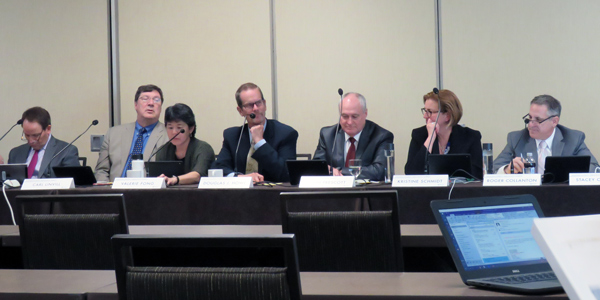By Jason Fordney
LOS ANGELES — Despite recent developments favoring more organized energy markets, Westerners still hold some “anxiety” and “hesitancy” about a new RTO in the region, says Doug Howe, chairman of the Western Energy Imbalance Market’s (EIM) Governing Body.
Howe, a doctor of mathematics, independent consultant, former utility executive and former New Mexico regulator, joined the body when it was established in 2016.
At an EIM meeting in Los Angeles last week, RTO Insider asked Howe how he sees the Western landscape taking shape, and what his concerns are about a possible new Western RTO.
“My sense is still that there is a lot of hesitancy towards a full RTO,” Howe said. “The idea of transmission allocation and a uniform transmission price across a region as big as the Western Interconnection gets a lot of people a little nervous, because we have widely varying transmission costs in the West.”
Several possible changes are stirring the West, including a joint proposal by Peak Reliability and PJM to create a new market and CAISO’s plan to extend its day-ahead market across the EIM. (See Calif. Lawmakers Relaunch CAISO Regionalization.)
While the Peak/PJM market proposal only sets out to establish an energy market, and not a full RTO, Peak executives have described it as a “pathway” to an RTO.
“All of these initiatives are in some sense a pathway to an RTO,” Howe said. The question is how to deliver the benefits of an RTO, such as day-ahead, real-time and ancillary services markets, “without triggering all this anxiety,” he said.
The best approach, according to Howe?
“Let’s get the energy markets established first and then we will see where stakeholders are comfortable going.”
Howe said industry participants have several choices to examine now and will be analyzing the costs and benefits of each one, “and whether it has sufficient bells and whistles — is it the right market to be in?”
One concern is “the absence of a real exit strategy” if a market participant joins an RTO, he said.
“If you find it’s not working out for you, getting out is extraordinarily expensive,” Howe said. While CAISO is seeking to extend the day-ahead market across the EIM, an RTO “is not what we are proposing at this point.” The trade-off is that participants don’t get the full benefits of an RTO either, he said.
When asked about whether there is unease about a balkanized and noncontiguous market taking shape, Howe said, “I don’t think there is a lot of concern about that.” The Eastern U.S. is balkanized to some degree and “it’s a spider web of transmission,” he said. In the West, transmission lines run north and south and east and west from the coast inland.
“They have worked that out in the East, but there is some concern that the West is not the same as the East, and that is going to be part of the working-out process,” Howe said. “There might be a little more concern about the reliability coordinator becoming balkanized, because they are the ones that have a high-level view of the entire grid.”





